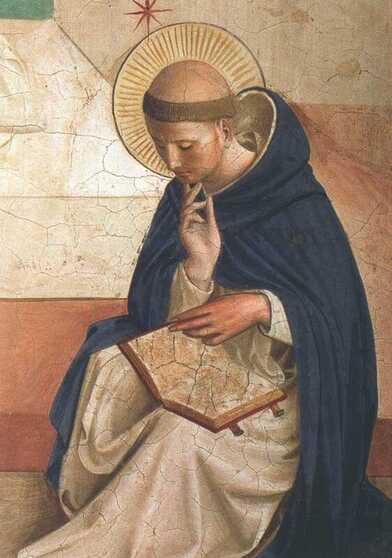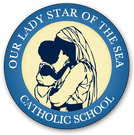LatinThe study of Latin is integral to a classical curriculum. By studying the language of the Romans, students not only learn the roots of many English words but also lay the foundation for further language study. Because the grammar of Latin is so regular and clearly formulated, their aptitude for understanding other languages (even non-Romance languages) increases.
At Our Lady Star of the Sea, students begin by memorizing Catholic prayers. Having learned various prayers, younger students then focus on learning vocabulary and derivatives. Older students learn various grammer forms in parallel to memorization of prayers and vocabulary. Ultimately, students lay a solid base for future language study. |
Music/Choir
Our curriculum uses John Feiraband’s Folk-Song focused “First Steps in Music” Curriculum in the Kindergarten,1st grade, and 2nd grade classroom. This curriculum uses simple songs (just a few notes) to develop solo singing and knowledge of basic solfege (i.e. singing a scale using do, re, mi fa sol, la, ti), pitch and movement exploration exercises, song tales, call and response songs, song games and dances. The difficulty of melodies and rhythms increases through the three grade levels.
In addition to the “First Steps” curriculum, students are exposed to a variety of classical pieces and composers with the added benefit of a guided discussion. An emphasis is also placed on learning chants and hymns to sing at mass and preparing for our Christmas and Spring Concerts.
In our 3rd and 4th grade music classroom the emphasis shifts to choral singing, especially with rounds, basic 2-3 part harmonies, and continuing with song dances. Students still follow the leveled rhythm curriculum, just increasing the difficulty. We have an increased emphasis on reading and following choral music. Our students learn how to develop their voice in a healthy and exciting way, through vocal exercises.
In addition to the “First Steps” curriculum, students are exposed to a variety of classical pieces and composers with the added benefit of a guided discussion. An emphasis is also placed on learning chants and hymns to sing at mass and preparing for our Christmas and Spring Concerts.
In our 3rd and 4th grade music classroom the emphasis shifts to choral singing, especially with rounds, basic 2-3 part harmonies, and continuing with song dances. Students still follow the leveled rhythm curriculum, just increasing the difficulty. We have an increased emphasis on reading and following choral music. Our students learn how to develop their voice in a healthy and exciting way, through vocal exercises.
5th and 6th Grade:
Students continue learning the mechanics of singing but become much more rooted in music theory and the theology of sacred music. The basis for this class is Gregorian chant and principally focuses on Gregorian notation.
Objective: Students should leave this class able to sing, particularly Gregorian chant, but with a foundation for choral singing and be able to sight-read basic music and understand the theory behind written music.
Students continue learning the mechanics of singing but become much more rooted in music theory and the theology of sacred music. The basis for this class is Gregorian chant and principally focuses on Gregorian notation.
Objective: Students should leave this class able to sing, particularly Gregorian chant, but with a foundation for choral singing and be able to sight-read basic music and understand the theory behind written music.
7th and 8th Grade:
Students continue learning the mechanics of singing and theory but also delve into the history of music and appreciation as listeners. While this course explores Gregorian chant, more time is spent on reading modern musical notation, understanding rhythms, and working toward singing polyphony. Students will have a major presentation to their class on a piece of historic Catholic music: its origins, composer, text, etc.
Objective: Students should leave this class able to sing in a variety of musical styles, able to read music well, with basic knowledge of the history of (mostly Catholic) music and able to appreciate it both liturgically and in casual listening.
Students continue learning the mechanics of singing and theory but also delve into the history of music and appreciation as listeners. While this course explores Gregorian chant, more time is spent on reading modern musical notation, understanding rhythms, and working toward singing polyphony. Students will have a major presentation to their class on a piece of historic Catholic music: its origins, composer, text, etc.
Objective: Students should leave this class able to sing in a variety of musical styles, able to read music well, with basic knowledge of the history of (mostly Catholic) music and able to appreciate it both liturgically and in casual listening.
Library
All grades have regularly scheduled time in our 9,000+ volume library.
Art
Our art docents present programs on the masterpieces to students in grades K-4. We emphasize art appreciation as well as hands-on exercise in a variety of styles. All teachers integrate art into the other subject areas such as Literature and History.
PHYSICAL EDUCATION
Our PE curriculum is composed of workouts that enhances the natural process of motor development which increases learning effectiveness and efficiency. We channel children's natural inclination for constant and varied movements.
The curriculum creates a physical learning environment that builds on the idea that all children have differing abilities and need to be challenged at different points of development. This differentiated instruction allows a child to continually and efficiently progress, minimizing the risk of frustration or stagnation. Every skill, every movement, every workout and every game can be scaled to a child’s ability (made easier or harder) so he or she is challenged. Main areas of fitness targeted are: cardiorespiratory endurance, stamina, strength, flexibility, power, speed, coordination, agility, balance and accuracy.
Each class includes a warm up, skill instruction, a workout of the day and a game. Games include: Musical Wall Balls, Empire Mania, Noodle Tag, Volcano Monster. Since OLSOS provides volleyball and basketball as extra-curricular sports, aspects of these games are presented during the year.
Every month, a bible verse is presented, discussed and reiterated throughout that month, to encourage the practice of the faith as its to be incorporated into all subjects and parts of a student’s life.
The curriculum creates a physical learning environment that builds on the idea that all children have differing abilities and need to be challenged at different points of development. This differentiated instruction allows a child to continually and efficiently progress, minimizing the risk of frustration or stagnation. Every skill, every movement, every workout and every game can be scaled to a child’s ability (made easier or harder) so he or she is challenged. Main areas of fitness targeted are: cardiorespiratory endurance, stamina, strength, flexibility, power, speed, coordination, agility, balance and accuracy.
Each class includes a warm up, skill instruction, a workout of the day and a game. Games include: Musical Wall Balls, Empire Mania, Noodle Tag, Volcano Monster. Since OLSOS provides volleyball and basketball as extra-curricular sports, aspects of these games are presented during the year.
Every month, a bible verse is presented, discussed and reiterated throughout that month, to encourage the practice of the faith as its to be incorporated into all subjects and parts of a student’s life.


